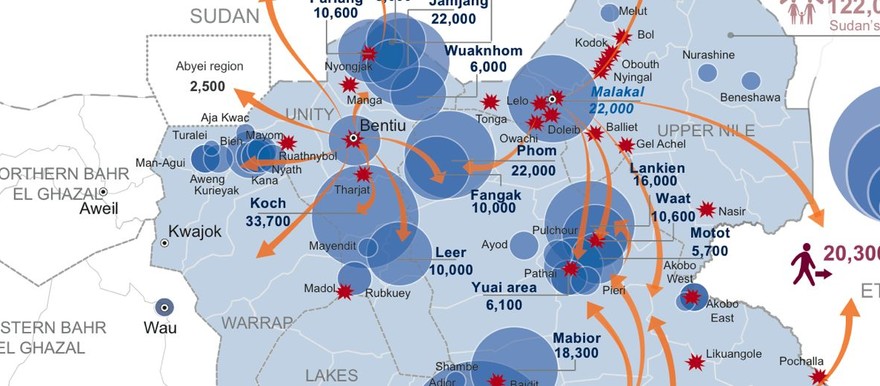UN aid agencies estimate that the number of people displaced by war in South Sudan is at least 5% of the population and probably significantly higher, and that the majority of those displaced have not been helped by international organizations.
A map (PDF) produced by the UN Office for the Coordination of Humanitarian Affairs (OCHA) shows refugee flows as well as estimates of the populations at various sites throughout the country.
The blue circles indicate displacement that occurred since the start of the current conflict, whereas refugee populations that were present in the country since before it started are indicated in red text only.
Explanatory text says that an estimated 490,600 have been displaced within South Sudan (IDPs) while another 83,900 crossed into neighboring countries, putting the figure for total displacement at 574,500.
South Sudan’s population is approximately 10.8 million, according to World Bank data, meaning that minimum 5.3% of the total population have been uprooted.
But in a footnote, the UN coordination agency states, “The total number of people displaced is likely higher, as aid agencies have very limited information about displacement outside main population centres.”
In particular, the UN appears to have very little information on the number of people in southern and eastern Unity State as well as western and central Upper Nile state in the areas to the north of Malakal.
Additionally, the UN does not necessarily tally as ‘displaced’ or as ‘refugees’ those people who simply left South Sudan without registering for assistance in another country, for example the tens of thousands of people who had their own means to travel by car, bus or airplane to places such as Kampala and Nairobi.
This suggests that the level of mass population movement may be far higher than the reported figures, especially since four of ten states have been heavily affected by violence.
The most affected states are Jonglei, Unity, Upper Nile and Central Equatoria, where several residential neighborhoods in the capital Juba have been almost entirely depopulated.
According to OCHA, 211,000 people have been assisted by humanitarian organizations since the start of the conflict, which means that well over half of those displaced have received from them no help.
Related: Map: Displacement and violence in South Sudan (31 Dec.)




